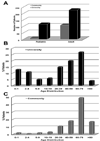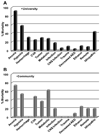Comparisons of the mortality and clinical presentations of status epilepticus in private practice community and university hospital settings in Richmond, Virginia
- PMID: 19324574
- PMCID: PMC2850102
- DOI: 10.1016/j.seizure.2009.02.005
Comparisons of the mortality and clinical presentations of status epilepticus in private practice community and university hospital settings in Richmond, Virginia
Abstract
We prospectively compared the clinical course of 119 patients treated for status epilepticus (SE) in private practice community hospitals and 344 SE patients treated in the VCU university hospitals in Richmond, Virginia USA over a 2-year period to test the hypothesis that SE presents with the same mortality and clinical patterns in both clinical settings. Of the patients reviewed, the major etiologies for SE were cerebrovascular disease, decreased anti-epileptic drug levels in epileptic patients, anoxia-hypoxia, and remote symptomatic. The other etiologies included were alcohol related, trauma, central nervous system infections, tumors, systemic infection, metabolic disorders, idiopathic, and hemorrhage. These observations provide the first direct prospective comparison of SE present in university and private practice community hospital settings in the same geographic area. Mortality was the highest in the elderly population while the pediatric population had low mortality in both clinical settings. Etiology risk factors for outcome were similar for both the populations. The data also suggest that the higher degree of illness severity in university hospitals may be associated with a higher incidence of SE, but not with mortality or a different clinical presentation of the condition. The results of this study demonstrate that SE has the same mortality and is present in an essentially identical manner in university and private practice community hospitals and underscores the fact that mortality in SE is not just associated with tertiary care hospitals and the importance of recognizing the severity of SE in the private practice setting.
Figures






References
-
- DeLorenzo RJ. Epidemiology and clinical presentation of status epilepticus. Adv Neurol. 2006;97:199–215. - PubMed
-
- Hauser WA. Status epilepticus: frequency, etiology, and neurological sequelae. Adv Neurol. 1983;34:3–14. - PubMed
-
- DeLorenzo RJ, Pellock JM, Towne AR, Boggs JG. Epidemiology of status epilepticus. J Clin Neurophysiol. 1995;12:316–325. - PubMed
-
- DeLorenzo RJ, Towne AR, Pellock JM, Ko D. Status epilepticus in children, adults, and the elderly. Epilepsia. 1992;33 S4:S15–S25. - PubMed
-
- Penberthy LT, Towne A, Garnett LK, Perlin JB, DeLorenzo RJ. Estimating the economic burden of status epilepticus to the health care system. Seizure. 2005;14:46–51. - PubMed
Publication types
MeSH terms
Grants and funding
LinkOut - more resources
Full Text Sources
Other Literature Sources

